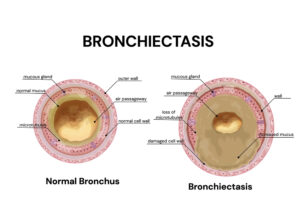Bronchiectasis
Bronchiectasis is a chronic respiratory condition characterized by the abnormal and permanent dilation of the bronchial tubes in the lungs. These dilated airways become damaged and lose their ability to effectively clear mucus and foreign particles, leading to recurrent infections and inflammation. Over time, this can result in further lung damage.

Symptoms of Bronchiectasis:
1. Chronic cough: Often producing large amounts of mucus, which can be foul-smelling.
2. Recurrent respiratory infections: People with bronchiectasis are more prone to bacterial infections in their airways.
3. Shortness of breath and wheezing: Due to the compromised lung function and narrowed airways.
4. Chest pain: Can occur due to inflammation and infection in the airways.
5. Fatigue: Difficulty breathing and chronic infections can lead to fatigue.
6. Clubbing of fingers and toes: In some cases, the tips of the fingers and toes may become enlarged and rounded.

Criteria for Diagnosis:
Diagnosing bronchiectasis typically involves a combination of clinical evaluation, medical history review, and various tests, including:
1. High-resolution computed tomography (HRCT) scan: This imaging test provides detailed images of the lungs, helping to visualize the bronchial dilation and confirm the diagnosis.
2. Sputum culture: Testing the mucus coughed up from the lungs can help identify any bacterial infections and guide appropriate antibiotic treatment.
3. Pulmonary function tests: These tests assess lung function and capacity, helping to determine the extent of lung damage.
4. Chest X-ray: Although less sensitive than HRCT, it may still show characteristic signs of bronchiectasis.
Causes of Bronchiectasis:
Bronchiectasis can be caused by various factors, including:
1. Infections: Severe or recurrent lung infections, such as pneumonia or tuberculosis, can lead to bronchiectasis.
2. Cystic fibrosis: This genetic disorder can cause thick, sticky mucus buildup in the airways.
3. Immune system disorders: Conditions that weaken the immune system can increase susceptibility to lung infections and bronchiectasis.
4. Airway blockages: Aspiration of foreign objects, tumors, or other conditions that obstruct the airways can lead to bronchiectasis.
5. Autoimmune diseases: Some autoimmune disorders can cause inflammation and damage to the airways.
Management of Bronchiectasis:
The management of bronchiectasis aims to alleviate symptoms, prevent complications, and improve overall lung function. Treatment strategies may include:
1. Antibiotics: To treat and prevent infections.
2. Bronchodilators: Medications that help open the airways and improve breathing.
3. Chest physiotherapy: Techniques to help clear mucus from the airways.
4. Mucus thinning medications: To make it easier to clear mucus.
5. Vaccinations: To prevent infections, especially against flu and pneumonia.
6. Pulmonary rehabilitation: A program to improve lung function, exercise tolerance, and overall quality of life.
7. Oxygen therapy: In advanced cases with severe lung damage, supplemental oxygen may be necessary.
8. Surgery: In some cases, surgical removal of severely damaged lung tissue may be considered.
It's important for individuals with bronchiectasis to work closely with their healthcare providers to develop a personalized treatment plan. Regular follow-ups and adherence to the prescribed treatment are essential to managing the condition effectively.

